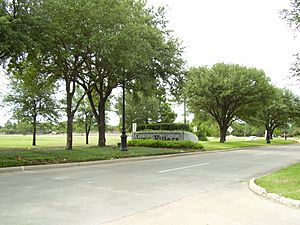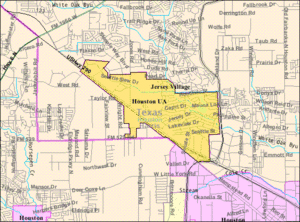Jersey Village, Texas facts for kids
Quick facts for kids
City of Jersey Village
|
|
|---|---|

Entrance to Jersey Village
|
|

Location in Harris County and the state of Texas
|
|
| Country | United States |
| State | Texas |
| County | Harris |
| Incorporated | April 16, 1956 |
| Area | |
| • Total | 3.43 sq mi (8.88 km2) |
| • Land | 3.38 sq mi (8.75 km2) |
| • Water | 0.05 sq mi (0.13 km2) |
| Elevation | 110 ft (33.5 m) |
| Population
(2020)
|
|
| • Total | 7,921 |
| • Density | 2,335.70/sq mi (901.70/km2) |
| Time zone | UTC-6 (CST) |
| • Summer (DST) | UTC-5 (CDT) |
| ZIP codes |
77040, 77041, 77065
|
| Area code(s) | 713 |
| FIPS code | 48-37612 |
| GNIS feature ID | 1360232 |
Jersey Village is a city in west-central Harris County, Texas, United States, located at U.S. Highway 290, Farm to Market Road 529, and the Southern Pacific Railroad. The city is located in the Houston–Sugar Land–Baytown metropolitan area. The population was 7,921 at the 2020 census.
Contents
History
The 1936 Harris County highway map indicated several residences in the area. Clark W. Henry owned 1,236 acres (5.00 km2) of land on which he operated F&M Dairy and raised Jersey cattle. Henry discontinued his dairy when his health declined, and he gave the land up so a residential community could be built in 1953. Henry and LeRoy Kennedy, members of the Garden Oaks Baptist Church, began developing the community in February 1954. At first, the city had 5 miles (8 km) of streets and drainage, gas, sewage, and water services. Several houses were established along Jersey Drive. The first family moved to the subdivision in late October 1954. The community developed a school, a park, and an 18-hole golf course. Jersey Village incorporated on April 16, 1956, with all 58 votes in favor of incorporation and a volunteer police force. Because of the incorporation, Houston did not incorporate Jersey Village's territory into its city limits.
In 1961, Jersey Village had 493 residents. On July 6, 1972, Leonard Rauch gave Jersey Village a city hall building; as of 2008 the building was used for the fire department and public works departments. In 1977 the city passed a bond issue, leading it to construct a new city hall, a city garage, a park pavilion, and an expansion of the fire department building. In 1980, the city had 966 residents. In 1982, this figure increased to 4,084. In August 1986, officials announced that the city passed a home rule charter, with a passing vote of 306–36. Under a home rule charter, Jersey Village gained more taxation and governing powers than it had as a general law city. In 1988 the population increased to 5,143. In 1990 Jersey Village had 4,938 residents.
Geography
Jersey Village is located at 29°53′26″N 95°34′7″W / 29.89056°N 95.56861°W (29.890569, –95.568579).
According to the United States Census Bureau, the city has a total area of 3.5 square miles (9.1 km2), of which 3.4 square miles (8.8 km2) is land and 0.04 square miles (0.10 km2), or 0.87%, is water.
Demographics
| Historical population | |||
|---|---|---|---|
| Census | Pop. | %± | |
| 1960 | 493 | — | |
| 1970 | 765 | 55.2% | |
| 1980 | 4,084 | 433.9% | |
| 1990 | 4,826 | 18.2% | |
| 2000 | 6,880 | 42.6% | |
| 2010 | 7,620 | 10.8% | |
| 2020 | 7,921 | 4.0% | |
| U.S. Decennial Census | |||
| Race | Number | Percentage |
|---|---|---|
| White (NH) | 4,113 | 51.93% |
| Black or African American (NH) | 906 | 11.44% |
| Native American or Alaska Native (NH) | 14 | 0.18% |
| Asian (NH) | 812 | 10.25% |
| Pacific Islander (NH) | 2 | 0.03% |
| Some Other Race (NH) | 24 | 0.3% |
| Mixed/Multi-Racial (NH) | 299 | 3.77% |
| Hispanic or Latino | 1,751 | 22.11% |
| Total | 7,921 |
As of the 2020 United States census, there were 7,921 people, 3,465 households, and 2,217 families residing in the city.
As of the census of 2000, there were 6,880 people, 2,840 households, and 1,942 families residing in the city. The population density was 2,014.3 inhabitants per square mile (777.7/km2). There were 3,037 housing units at an average density of 889.2 per square mile (343.3/km2). The racial makeup of the city was 86.6% White, 4.1% African American, 0.1% Native American, 5.09% Asian, 0.06% Pacific Islander, 2.43% from other races, and 1.51% from two or more races. Hispanic or Latino of any race were 7.3% of the population.
There were 2,840 households, out of which 29.0% had children under the age of 18 living with them, 59.6% were married couples living together, 6.2% had a female householder with no husband present, and 31.6% were non-families. 24.8% of all households were made up of individuals, and 2.5% had someone living alone who was 65 years of age or older. The average household size was 2.42 and the average family size was 2.94.
In the city, the population was spread out, with 22.0% under the age of 18, 8.8% from 18 to 24, 31.6% from 25 to 44, 30.0% from 45 to 64, and 7.6% who were 65 years of age or older. The median age was 38 years. For every 100 females, there were 97.9 males. For every 100 females age 18 and over, there were 96.5 males.
The median income for a household in the city was $68,431, and the median income for a family was $82,689. Males had a median income of $53,984 versus $37,616 for females. The per capita income for the city was $36,092. About 3.4% of families and 4.5% of the population were below the poverty line, including 6.4% of those under age 18 and 5.8% of those age 65 or over.
Education
Primary and secondary schools
Jersey Village is served by Cypress-Fairbanks Independent School District. Jersey Village's residential areas are zoned to Post Elementary School, which is located in Jersey Village. Students continue on to Cook Middle School in unincorporated Harris County and Jersey Village High School in Jersey Village. Some areas within the Jersey Village city limits are zoned to other elementary and middle schools, but this is without real significance as these areas currently have no residents.
When Jersey Village opened, children originally went to Cy-Fair High School for schooling. A high school site opened in Jersey Village, and Jersey Village High School opened in 1972.
Gallery of schools
Colleges and universities
Lone Star College (originally the North Harris Montgomery Community College District) serves the community. The territory in Cypress-Fairbanks ISD joined the community college district in 2000. The Texas Legislature has designated CFISD as being in the Lone Star district. The system operates the Fairbanks Center in unincorporated Harris County; Fairbanks Center is a part of Lone Star College–CyFair.
Recreation
Jersey Village offers residents a variety of recreational activities. The town has a golf course, public swimming pool, and public park with playground facilities. There is also a small lake owned and maintained by a Homeowners Association with fishing available to residents and guests who have homes on the shores of the lake.
Notable person
- Gary Elkins, Republican member of the Texas House of Representatives from District 135 in Harris County from 1995 to 2018; defeated for re-election in 2018
Gallery
-
Jersey Village and its water tower seen from U.S. Highway 290
See also
 In Spanish: Jersey Village para niños
In Spanish: Jersey Village para niños





